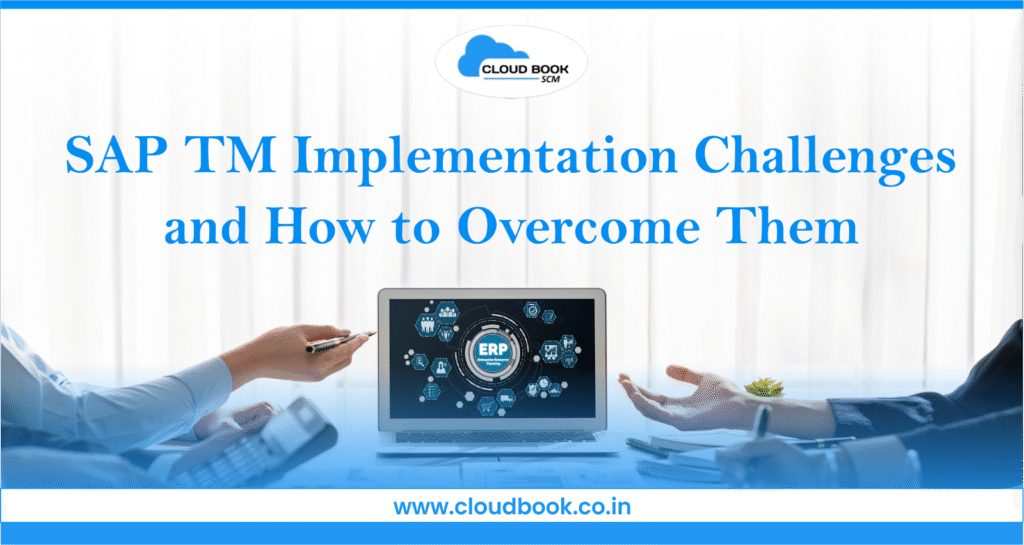SAP TM Implementation Challenges and How to Overcome Them

SAP TM Implementation Challenges and How to Overcome Them
Transportation management has become a key factor in achieving business success in contemporary global supply chains. That is where SAP Transportation Management (SAP TM) steps in to automate the planning, execution, and settlement of freight, providing organizations with real-time visibility and improved cost management.
However, despite all the advantages, SAP TM implementation can become one of the most challenging projects that companies must undertake. Aligning the ERP and warehouse systems to process freight order differences is fraught with possible setbacks. Not only do they create technical snags, but they also directly impact customer satisfaction, compliance, and profitability.
This blog addresses the common SAP implementation challenges in TM. It provides straightforward and viable solutions to the problems, enabling learners, professionals, and organizations to navigate the process with confidence.
Understanding SAP TM Implementation
It is essential to understand what SAP TM implementation entails before tackling the challenges. SAP Transportation Management is not a plug-and-play software, but rather a highly integrated application that connects transportation planning, freight execution, carrier management, and financial settlement to the bigger ERP world.
Implementing a tool is not just the incorporation of a tool when an organization is about to implement SAP TM. Instead, it includes redefining the communication process among logistics, finance, and supply chain teams. This is why SAP TM projects require a significant amount of planning, knowledge, and staged implementation.
Why SAP TM Implementation Is Challenging
The question many professionals ask is: Why do SAP implementation challenges feel especially pronounced in Transportation Management?
The solution can be found in the extent of logistics activities. SAP TM is responsible for managing international freight planning through carrier invoicing and billing. One misconfiguration or ineffective integration will result in delays in shipments, wrong invoices, or even compliance violations. For example:
- An international producer that uses TM may discover that its freight optimizer books shipments effectively; however, interface discrepancies with ERP imply that invoices are pending.
- A retailer can also suffer system resets when planning dates that leave warehouses without loading slots.
They are not small-scale technical snags, but instead directly affect supply chain continuity and customer satisfaction, and are thus, by definition, complex to implement.
Common Challenges in Implementing SAP TM

1. Problems with SAP Implementation and Their Impact on SAP TM
The general SAP implementation challenges are one of the most significant problems that spill over to TM projects. Uncommonly, organizations do not estimate resources needed, and as such:
Delayed project timelines.
- Stretched-thin teams are attempting to handle ERP and TM rollouts simultaneously.
- Misaligned IT and logistics due to misset workflows.
For example, when the finance team and logistics team fail to reach a consensus on the allocation of freight costs, the TM system may post settlements based on an incorrect basis, resulting in reporting variances.
Solution:
- Engage the cross-functional stakeholders at the beginning of the project to facilitate good cooperation.
- Develop an achievable roadmap and contingency plan to ensure a smooth transition.
- Dedicate a specific team to the implementation of the TM instead of overstraining the ERP resources.
2. Difficulties of the SAP TM Module During Implementation
The flexibility and configuration depth of SAP TM are powerful. But that flexibility may be a trap:
- Upgrades are costly, and testing is required due to over-customization
- Conflicts between TM and other SAP modules, such as ERP or S/4HANA.
- Planning failures occur due to data inconsistency (e.g., incomplete freight master data).
Consider a logistics firm that assigns complex freight orders to specific pathways. Each update causes conflict without proper governance and therefore requires re-testing.
Solution:
- Utilize SAP standard processes to the maximum extent possible.
- Perform pilot settings, then go to the full scale of transport streams.
- Validate and cleanse logistics data before migration.
3. Discrepancies in SAP TM and How to Resolve Them
One of the most apparent difficulties of implementing SAP for TM users is the discrepancy. These may include:
- Variations between budgeted freight expenditures and those that actually occur.
- Quantity mismatches in freight orders.
- System resets, such as SAP updating transportation planning dates to the current date, are unexpected and can cause disruptions. And can cause disruptions.
For example, when a planned freight is $ 5,000 and the invoices represent $5,300, the financial postings can be inhibited, delaying settlements with carriers.
Solution:
- Establish the tolerance levels in the profile of the discrepancies.
- Enable automated discrepancy reporting within freight orders.
- Condition users on trains to expedite the resolution of discrepancies.
4. Integration Challenges with SAP ERP and EWM
TM does not exist in a standalone space; it must communicate with finance (through ERP) and the warehouse (through EWM). This integration is often complex, which often leads to:
- Data duplication, or non-updating across systems.
- Delays in freight order status updates.
- Misalignment between warehouse loading and transportation scheduling.
As a case in point, when a warehouse system updates product quantities but the TM is not updated in real-time, it becomes apparent that shipments can be planned with obsolete information.
Solution:
- Use middleware with robust data mapping tools.
- Schedule regular validation checks between systems.
- Host cross-functional workshops with ERP and logistics teams.
5. Change Management and User Adoption Issues
Human resistance can thwart SAP TM projects even in cases where their design is impeccable. New workflows may become tedious for users or may be tied to outdated systems. In an unstructured change management:
- Adoption remains low.
- Workarounds reappear by hand.
- The implementation does not cause ROI for businesses.
Solution:
- Run continuous, role-based training programs.
- Direct departmental super users.
- Effectively conveying the business value of TM to the end users.
The SAP TM Implementation Process
The question often arises: What are the typical steps in implementing SAP TM, and where do challenges occur?
The implementation lifecycle typically looks like this:
1. Requirement Gathering & Business Alignment
- The logistics of the map require SAP TM power.
- Issue: Disconnection between the IT and logistics interests.
2. System Design & Configuration
- Tailor freight order types, planning logic, and carriers.
- Issue: Excessive customization that results in complexity in the future.
3. Integration with ERP, EWM, and Third-Party Systems
- Establish connections with finance, warehouse, and tracking systems.
- Issue: Data syncing, record duplication, and downtime.
4. Testing (SIT & UAT)
- Validate real-life freight scenarios, settlements, and reporting.
- Issue: The test data is not fully available, or the number of entries is minimal.
5. Go-Live & Support
- Transition into daily operations with monitoring and escalation paths.
- Issue: Improper end-user resistance, unrecorded, and receiving no after-sales service.
Organizations can create better controls at every implementation stage by anticipating these challenges.
Testing and Validation Challenges
Testing in SAP TM is often underestimated, yet it can significantly impact the success or failure of a rollout. Common issues include:
- Applying dummy data that does not indicate the objective complexity of the supply chain.
- Does not include special situations such as international deliveries or hazardous products.
- User Acceptance Testing (UAT) is often rushed, leaving users unprepared to operate it live.
For example, a company that only tests domestic freight orders might face failures when international orders require customs documents at go-live.
Solution:
- Conduct end-to-end simulations in sandbox environments.
- It is necessary to involve the business users at an early stage in test planning.
- Verify edge cases and compliance cases, not merely happy cases.
Final Thoughts: Navigating SAP TM Implementation Challenges
Implementing a SAP Transportation Management system does not come easily; it also requires careful planning. The challenges, whether they be variations in freight orders, integration challenges, or change management challenges, can all be addressed using the right attitude.
SAP TM implementation should be regarded as both a technical project and a business change. Organizations can achieve strategic logistics efficiency through the complex SAP TM system by implementing it in stages, maintaining good governance, providing practical training, and offering continuous support.
At our SAP TM training at SCM Cloudbook, we train learners on both theoretical and practical knowledge to resolve real-life challenges. Whether it’s a different resolution or integration, our programs prepare you for a job-ready role and help you overcome SAP implementation challenges.
👉 Ready to prepare for the real world of SAP TM? Enroll with SCM Cloudbook today and take the first step confidently into your SAP career.



